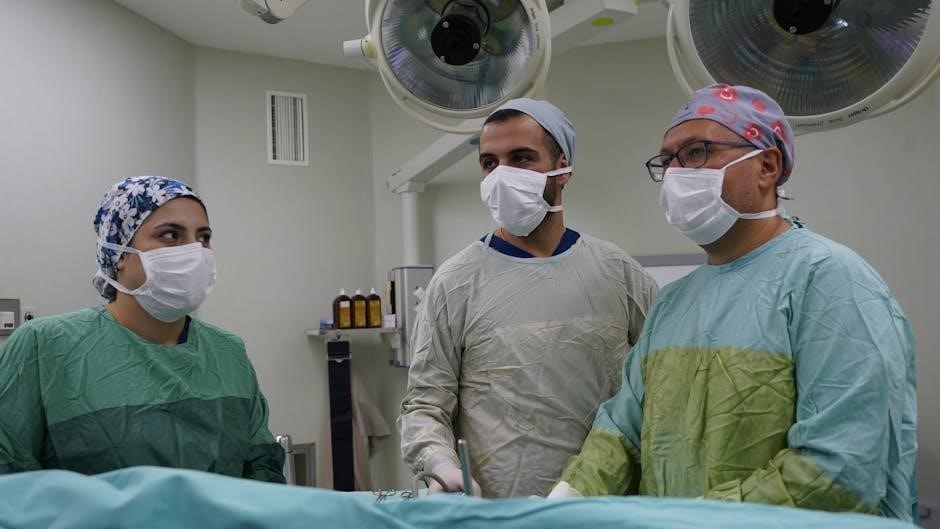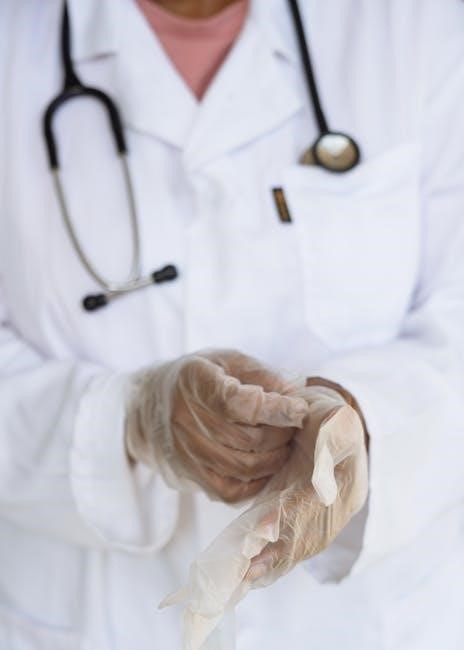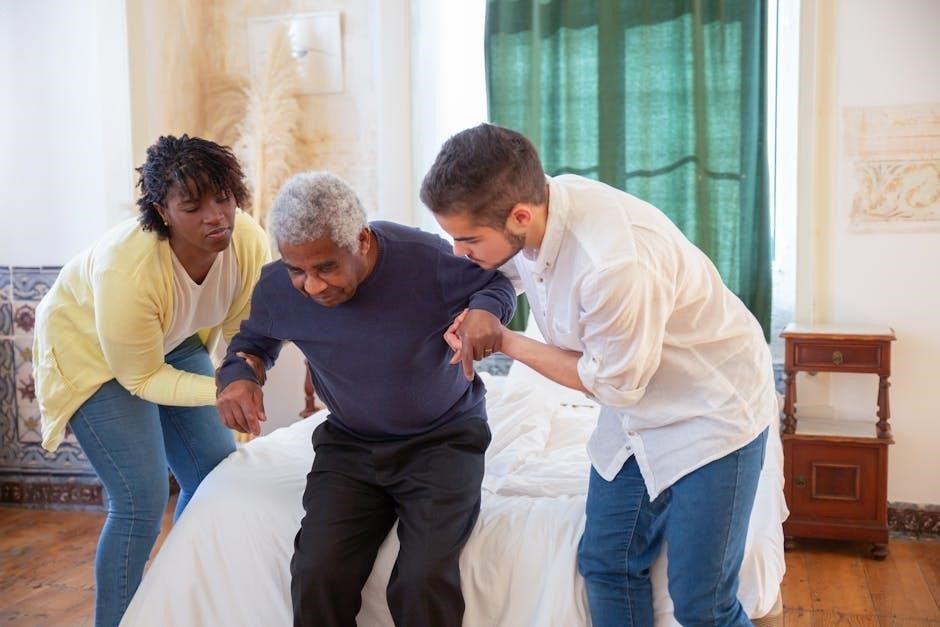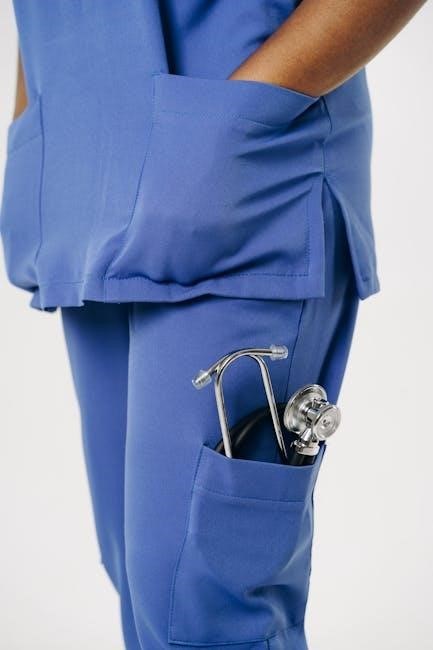A Nurse’s Pocket Guide is a portable resource for nurses, containing essential protocols, guidelines, and assessment tools. It aids in decision-making, ensuring accurate patient care and adherence to best practices. This guide is indispensable for nursing professionals, providing quick access to critical information and promoting efficiency in daily tasks.
What is a Nurse’s Pocket Guide?
A Nurse’s Pocket Guide is a compact, portable resource designed for nursing professionals. It contains essential clinical guidelines, diagnostic tools, and medication information, serving as a quick reference for daily patient care. The guide is structured to provide clear, concise instructions and protocols, ensuring accuracy and efficiency in decision-making. Updated regularly, it reflects current best practices, making it a trusted tool for nurses to deliver high-quality care in various healthcare settings.
Importance of a Pocket Guide for Nurses
A Nurse’s Pocket Guide is a vital tool that ensures nurses can access critical information quickly and accurately. It serves as a quick reference for clinical decision-making, reducing errors and improving patient outcomes. The guide enhances efficiency, allowing nurses to focus on providing high-quality care. By standardizing practices, it promotes consistency and adherence to best practices across healthcare settings, making it an indispensable resource for both experienced professionals and new graduates.

Vital Signs and Measurement
Vital signs, including temperature, pulse, respiration, and blood pressure, are crucial for assessing patient health. Accurate measurement ensures timely identification of normal or abnormal findings, guiding care decisions.
Normal Ranges for Vital Signs
Normal vital sign ranges are essential for assessing patient health. Body temperature typically ranges from 97.7°F to 99.6°F (36.5°C to 37.5°C). Pulse rate for adults is usually between 60 to 100 beats per minute (bpm), while respiratory rate ranges from 12 to 20 breaths per minute. Blood pressure should ideally be less than 120/80 mmHg, and oxygen saturation should be above 95% on room air. Accurate measurement and documentation of these values are critical for identifying deviations from normal.
How to Accurately Measure Blood Pressure
To measure blood pressure accurately, ensure the patient is seated comfortably with their arm at heart level. Use an appropriately sized cuff for the patient’s arm circumference. Inflate the cuff to 20-30 mmHg above the palpated systolic pressure. Place the stethoscope over the brachial artery and slowly deflate the cuff while listening for Korotkoff sounds. Record the systolic pressure at the first sound and diastolic when sounds disappear. Document the reading for reference.
Interpreting Abnormal Vital Sign Findings
Accurate interpretation of abnormal vital signs is critical for patient care. Elevated body temperature may indicate infection or inflammation. Tachycardia could signal stress, pain, or dehydration. Bradypnea may suggest respiratory distress or neurological compromise. Hypertension could point to cardiovascular issues or stress. Low oxygen saturation may indicate respiratory or cardiac problems. Nurses must promptly document and report abnormal findings to guide timely interventions and ensure patient safety.

Medication Administration Basics
Medication administration basics involve the 5 rights: right patient, drug, dose, route, and time. Ensure proper identification and documentation to maintain patient safety and adherence to protocols.
Key Principles of Safe Medication Administration
Safe medication administration relies on the 5 rights: right patient, right drug, right dose, right route, and right time. Always verify orders and patient identity. Use barcode scanning if available. Check for allergies, contraindications, and drug interactions. Ensure accurate calculation of doses, especially for pediatric or geriatric patients. Document administration promptly and accurately. Maintain aseptic technique for injectable medications. Monitor for adverse effects and report them immediately. Never administer medications without proper authorization.
Common Medication Errors and How to Avoid Them
Common medication errors include wrong drug errors, dosage miscalculations, and missed administration times. To prevent them, always double-check medication orders and patient identities. Use barcode scanning systems when available. Avoid distractions during administration; Ensure accurate dose calculations, especially for pediatric or elderly patients. Maintain a clean and organized workspace to reduce mix-ups. Use standardized tools and protocols to minimize variability. Report errors promptly and engage in continuous education to stay updated on best practices.
Understanding Drug Dosages and Calculations
Accurate drug dosages and calculations are critical to patient safety. Nurses must master methods like body weight-based dosing, especially for pediatric or obese patients. Use formulas or calculators to avoid errors. Always verify calculations with a colleague. Understand common formulas, such as dose per body surface area. Double-check drug labels and orders for clarity. Consult pharmacists for complex cases. Maintain a reference guide for drug dosages and interactions to ensure precision in administration.

Common Medical Abbreviations and Terminology
Mastering medical abbreviations and terminology is essential for clear communication. Common terms like BP (blood pressure) and HR (heart rate) streamline documentation and patient care.
Frequently Used Nursing Abbreviations
Nurses rely on abbreviations to streamline communication and documentation. Common ones include VS (vital signs), IV (intravenous), PO (oral), and IM (intramuscular). Others like HR (heart rate), RR (respiratory rate), and BP (blood pressure) are vital for patient assessments. Understanding these abbreviations ensures clarity and efficiency in patient care, reducing errors and enhancing teamwork. Familiarity with these terms is crucial for effective documentation and communication in fast-paced healthcare settings.
Medical Terminology Every Nurse Should Know
Understanding medical terminology is essential for effective nursing practice. Key terms include prefixes (e.g., “hypo-” for low), suffixes (e.g., “-itis” for inflammation), and root words (e.g., “cardio-” for heart). Common terms like hypertension (high blood pressure) and tachycardia (rapid heart rate) are frequently used. Accurate interpretation ensures clear communication and proper documentation, enhancing patient care and safety. Mastery of this terminology is vital for all nurses to provide high-quality, informed care.
Decoding Prescriptions and Orders
Accurately interpreting prescriptions and orders is a critical skill for nurses. Prescriptions typically include the patient’s name, date, medication name, dosage, route, frequency, and prescriber’s details. Abbreviations like PO (oral) or IV (intravenous) are common. Symbols such as → (change to) or ≠ (not equal to) may also appear. Understanding these elements ensures safe administration and compliance with medical orders. This skill is fundamental for preventing errors and delivering effective patient care.

Patient Assessment and Documentation
Patient assessment involves a systematic approach to evaluate physical, emotional, and functional status. Accurate documentation ensures continuity of care, legal compliance, and clear communication among healthcare providers.
Conducting a Comprehensive Patient Assessment
A comprehensive patient assessment involves evaluating physical, emotional, and functional status through observation, measurement, and patient interviewing. Key components include reviewing medical history, vital signs, medications, and diagnostic results. Nurses should systematically assess body systems, noting abnormalities or changes. Accurate documentation ensures individualized care plans and continuity of treatment. Regular reassessment helps monitor progress and identify new concerns, fostering timely interventions and improved patient outcomes.
- Assess physical and emotional health status.
- Evaluate vital signs and diagnostic data.
- Document findings to guide care planning.
- Monitor changes and adjust interventions as needed.
Effective Documentation Techniques
Accurate and timely documentation is essential for delivering high-quality patient care. Use clear, concise language, and avoid abbreviations or jargon. Document observations, interventions, and patient responses promptly. Organize records chronologically and ensure legibility. Include subjective, objective, assessment, and plan (SOAP) notes for structured reporting. Verify accuracy and completeness before finalizing entries. Use standardized tools or templates to enhance consistency and compliance with healthcare standards. Regularly review and update records to reflect ongoing care.
- Use clear and precise language in documentation.
- Record observations and interventions promptly.
- Utilize SOAP notes for structured reporting.
- Review and update records regularly.
Legal Aspects of Nursing Documentation
Nursing documentation must adhere to legal standards to protect patient rights and ensure accountability. Maintain confidentiality and comply with HIPAA regulations. Accurate and truthful records are essential, as false documentation can lead to legal consequences. Obtain informed consent before sharing patient information. Understand liability risks associated with incomplete or inaccurate records. Familiarize yourself with state and federal laws governing documentation practices. Proper documentation supports legal defense and upholds professional integrity.
- Adhere to HIPAA regulations for patient confidentiality.
- Ensure accuracy and truthfulness in records.
- Understand legal implications of incomplete documentation.
- Familiarize yourself with state and federal laws.

Patient Safety and Infection Control
Patient safety and infection control are critical to preventing harm and ensuring quality care. Strategies include proper hand hygiene, fall prevention, and isolation precautions to minimize risks.
Preventing Falls in Healthcare Settings
Preventing falls in healthcare settings involves assessing patients for fall risks, implementing individualized care plans, and ensuring safe environments. Use tools like BEDSIDE manner to identify risks. Clear clutter, ensure proper lighting, and use non-slip footwear. Encourage patients to ask for help when moving and educate them on safety measures. Regularly review and update fall prevention plans with the healthcare team to adapt to changing patient conditions and ensure a safe care environment.
Proper Hand Hygiene Techniques
Proper hand hygiene is essential for preventing infections. Use alcohol-based hand rub or soap and water for at least 20 seconds. Apply hand rub to palm, back, fingers, and thumbs, ensuring full coverage. Wash hands with soap and water when visibly soiled. Avoid jewelry during handwashing. Dry thoroughly and moisturize to prevent dryness. Perform hand hygiene before patient contact, after removing gloves, and after exposure to bodily fluids or contaminated surfaces to maintain patient and staff safety.
Isolation Precautions for Infectious Diseases
Isolation precautions prevent the spread of infectious diseases. Use personal protective equipment (PPE) like masks, gowns, and gloves based on infection type. Practice contact, droplet, or airborne precautions as needed. Place patients in private rooms or cohort care. Limit movement and ensure proper PPE use. Educate patients and families on isolation protocols. Adhere to guidelines consistently to protect patients, visitors, and staff from infection transmission in healthcare settings.

Communication Skills for Nurses
Effective communication builds trust, ensures accurate care, and supports patient-centered care. Active listening, empathy, and clear language are essential. Adapt communication to patient needs, cultures, and preferences.
Effective Communication with Patients
Effective communication with patients is vital for building trust and ensuring high-quality care. Nurses should practice active listening, use plain language, and show empathy. Be attentive to non-verbal cues like eye contact and body language. Adapt communication to meet patients’ cultural and language needs. Avoid jargon and clarify information to ensure understanding. Validate patients’ feelings and involve them in decision-making to foster a collaborative care environment. Clear communication enhances patient satisfaction and improves health outcomes.
Communicating with Colleagues and Interdisciplinary Teams
Effective communication with colleagues and interdisciplinary teams ensures seamless patient care and collaboration. Nurses should maintain clarity, conciseness, and professionalism in their interactions. Practice active listening and confirm understanding to avoid miscommunication. Use structured communication tools like SBAR (Situation, Background, Assessment, Recommendation) for critical information. Ensure timely handoffs and updates during shift changes. Leverage electronic communication tools like EHRs for documentation and accessibility. Address conflicts respectfully and focus on shared goals to enhance teamwork and patient outcomes.
Cultural Competence in Nursing Practice
Cultural competence in nursing involves understanding and respecting diverse patient backgrounds, beliefs, and practices. Nurses must recognize cultural differences in health behaviors, communication styles, and pain expressions. Providing culturally sensitive care fosters trust and improves patient outcomes. Learn about common cultural practices, use interpreters when needed, and adapt care plans to meet individual needs. Embrace diversity, promote inclusivity, and address biases to deliver equitable care. Cultural humility enhances therapeutic relationships and patient satisfaction.

Emergency Care and First Aid
Emergency care involves rapid assessment, basic life support, and managing acute conditions. Key skills include CPR, wound care, and handling seizures or anaphylaxis effectively.
Basic Life Support and CPR
Basic Life Support (BLS) includes critical skills like CPR, airway management, and rescue breathing. Nurses must master the C-A-B (Compressions, Airway, Breathing) approach for cardiac arrest scenarios.
High-quality chest compressions (100-120/min) and adequate ventilation (2 breaths after 30 compressions) are essential. Automated External Defibrillators (AEDs) should be used if available. Training and practice ensure proficiency in these life-saving techniques, which are vital for improving patient outcomes during emergencies.
Managing Choking and Airway Obstruction
Choking occurs when an object blocks the airway, preventing breathing. Immediate action is critical to restore airflow. For adults and children, stand behind the person and perform abdominal thrusts. For infants, use back slaps and chest thrusts. If the person becomes unresponsive, begin CPR. Always call for emergency assistance if choking persists or if the individual loses consciousness. Proper technique is essential to dislodge the object safely and effectively.
Responding to Seizures and Anaphylaxis
Responding to Seizures and Anaphylaxis
During a seizure, ensure the patient’s safety by clearing the area of hazards and turning them onto their side. Do not restrain or insert objects into the mouth. For anaphylaxis, administer epinephrine via an auto-injector if available, and call for emergency assistance. Monitor vital signs and maintain an open airway. Provide emotional reassurance and stay with the patient until help arrives. Quick intervention is crucial to prevent complications and improve outcomes.

Ethical and Legal Considerations
Ethical and legal considerations are fundamental to nursing practice, ensuring patient-centered care, privacy, and adherence to laws. They guide decision-making and professional conduct, preventing legal issues.
Confidentiality and Patient Privacy
Confidentiality and patient privacy are ethical and legal cornerstones in nursing. Nurses must safeguard patients’ personal and medical information, adhering to laws like HIPAA. Access to records should be limited to authorized personnel, and discussions about patient care must occur in private settings. Breaches of confidentiality can lead to legal consequences and loss of trust. Nurses should also educate patients about their rights regarding privacy and ensure proper storage and disposal of medical records to prevent unauthorized access.
Informed Consent and Patient Rights
Informed consent ensures patients are fully aware of their care options, risks, and benefits. Nurses play a key role in facilitating this process, ensuring patients understand information and make voluntary decisions. Patients have the right to accept or refuse treatment, and their autonomy must be respected. Nurses should verify that patients have the capacity to consent and provide documentation. Understanding patient rights, such as access to care and dignity, is essential for ethical nursing practice and building trust in the patient-provider relationship.
Understanding Scope of Practice
Scope of practice defines the responsibilities and boundaries of nursing care, varying by state and professional role. Nurses must adhere to their legal scope, ensuring they only perform tasks they are licensed and trained for. Exceeding scope can lead to legal consequences, while staying within it ensures safe, ethical care. Nurses should familiarize themselves with state-specific regulations and seek guidance when uncertain; This ensures clarity in roles, promoting patient safety and professional accountability.

Technology in Nursing Practice
Technology enhances nursing care through tools like EHRs, telehealth, and medical apps, improving patient monitoring, data management, and communication, while streamlining workflows and reducing errors.
Using Electronic Health Records (EHRs)
EHRs streamline patient care by providing instant access to medical histories, test results, and treatment plans. Nurses can document care accurately and efficiently, reducing errors. EHRs enhance communication among healthcare teams, allowing secure sharing of patient information. They also support clinical decision-making with built-in guidelines and alerts. Regular training and updates help nurses master EHR systems, ensuring seamless integration into daily practice and improved patient outcomes.
Telehealth and Remote Patient Monitoring
Telehealth enables nurses to deliver care remotely, improving access for patients with limited mobility. Remote monitoring devices track vital signs, such as blood glucose and blood pressure, allowing early detection of changes. This technology reduces hospital readmissions and enhances chronic disease management. Nurses can provide guidance via video calls and store data in EHRs for continuity of care. Telehealth also supports patient education, empowering individuals to manage their health effectively.
Medical Apps for Nurses
Medical apps for nurses provide essential tools for clinical decision-making and patient care. Apps like medication guides, dosing calculators, and clinical reference tools enhance efficiency. They offer drug information, lab value interpreters, and nursing diagnosis guides. Apps also facilitate communication with interdisciplinary teams and provide patient education materials. These resources support evidence-based practice, reduce errors, and improve patient outcomes, making them indispensable for modern nursing practice.